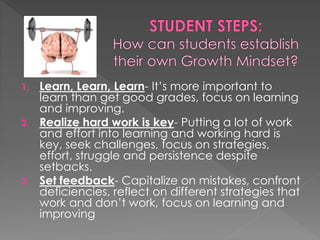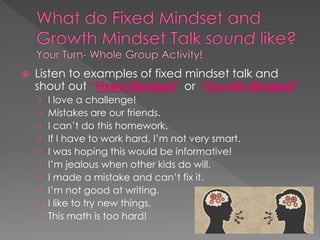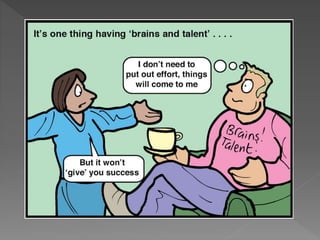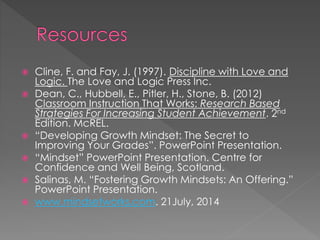Growth mindset
- 3. The brain is static. Talent and Giftedness are permanent. The brain is malleable. Every time you learn something new, the brain forms new connections.
- 4. 1. Learn, Learn, Learn- It’s more important to learn than get good grades, focus on learning and improving. 2. Realize hard work is key- Putting a lot of work and effort into learning and working hard is key, seek challenges, focus on strategies, effort, struggle and persistence despite setbacks. 3. Set feedback- Capitalize on mistakes, confront deficiencies, reflect on different strategies that work and don’t work, focus on learning and improving
- 5. Listen to examples of fixed mindset talk and shout out “Fixed Mindset!” or “Growth Mindset!” › I love a challenge! › Mistakes are our friends. › I can’t do this homework. › If I have to work hard, I’m not very smart. › I was hoping this would be informative! › I’m jealous when other kids do will. › I made a mistake and can’t fix it. › I’m not good at writing. › I like to try new things. › This math is too hard!
- 7. 1. Praise effort 2. Help set learning goals 3. Provide a safe, nurturing environment for students to learn
- 8. “The key to rewarding effectively is to do so in ways that support students’ motivation to learn and do not encourage them to conclude that they engage in academic activities only to earn rewards.” -Jere Brophy, Motivating Students to Learn
- 9. Students praised for effort overwhelmingly (90%) chose more challenging tasks and showed higher levels of engagement and achievement. Students praised for intelligence selected easier tasks when given the choice and lied about their scores in an effort to look smart. (Dweck, 1998) When teachers use an approach that bases student success on mastery of the task rather than on comparison to others’ performance, praise can be used to promote student engagement and decrease behavioral problems. (Moore-Partin, Robertson, Maggin, Oliver, & Welby, 2010).
- 10. Praise PROCESS, avoid labeling intellect! › Specific effort › Taking on difficult and/or complex tasks › Learning something new › Improving on something › Persistent struggle › Use of strategies
- 11. Reinforce what effort is and how knowledge about effort translates into success inside and beyond the classroom. Keep praise simple and direct, using straightforward sentences without gushing or dramatization. Specify particular accomplishment, pointing out any noteworthy effort, care, or perseverance Call attention to new skills or evidence of progress. Vary the phrases you use to praise and use nonverbal communication to convey warmth and appreciation for students’ efforts and achievements (Dean, Hubbell, Pitler, & Stone, 2010)
- 12. At your table sort the bag of praise quotes into two piles: › Praising Intellect › Praising Effort AllWrite RoundRobin: › When finished write down two examples of praise in your Interactive PD Notebook that you: Use often, but should use less of. Use rarely, but should use more of. › Then share take turns sharing with table.
- 13. Praising Intellect “You’re a great kid” is general. “That’s a great job” is judgmental. “I really like that paper” places value upon quality of the performance or product. “I’m so proud of the way you work in school” emphasizes the feelings of the person doing the praising. Praise creates cognitive dissonance (mental stress or discomfort when two contradictory beliefs are held) in students with low self-concepts. Most teachers tend to use this type of praise. Praising Effort “You got eight out of ten correct” is specific. “I noticed that you were taking turns on the playground today” is descriptive and allows student to do the judging. “I bet you worked hard on this one” emphasizes and values the effort. “Wow, five out of five! I bet that feels great!” emphasizes the feelings of the student. Praising for effort reduces the chance of cognitive dissonance. Allows students to reflect on their own effort! Similar to encouragement.
- 14. Those with a FIXED MINDSET tend to create PERFORMANCE goals. › They believe that a person’s potential can be can measured. They aim to receive validation from others. › Receiving low marks means that they are not smart. › Both success and failure cause anxiety. Those with a GROWTH MINDSET tend to create LEARNING goals. › The goal is mastery and competence. › Scores and marks reflect how people are doing now and do not measure a person’s potential. › Creating goals for learning has shown to increase performance and enjoyment and decrease negative emotion.
- 15. Helps students think: “How did I grow today?” 1. Guide a discussion about setting goals. 2. Talk about our own goal setting, or even people like Michael Jordan or Albert Einstein, we can teach the students that every successful person put in the effort to reach their goal, even making mistakes along the way. 3. Guide students to make Growth Goals on a daily, weekly, monthly, or quarterly basis. 4. Goals can be related to reading, math, study habits, behavior, or character. 5. Define the goal in student friendly terms using “I Can” statements. “I can practice my reading fluency every night.” “I can fix my mistakes in Writing without getting upset.” Set SMART goals- Be sure to make them Specific, Measureable, Attainable, Relevant, and Timely 6. Regularly reflect on their goal and accomplishment. 7. Have students keep track in Effort Logs or Data Notebooks.
- 16. Use these Go-To slogans to help remind your students that they’re goals are achievable if they put in the effort. › “A problem is a chance for you to do your best.” › “OK, we’ve recognized the problem…that’s the first step to solving it.” › “So here’s the challenge… here’s an opportunity to…”
- 17. Choose one of our Fixed Mindset Talk phrases below and turn it into a Growth Goal. Use the Growth Goal template to help write your goal. Be sure to make it an “I CAN” statement and SMART Goal! › I can’t do this homework. › If I have to work hard, I’m not very smart. › I made a mistake and can’t fix it. › I’m not good at writing. › I’m jealous when other kids do well. › This math is too hard! Timed Pair Share- Share with a partner at your table for 1 minute and talk about how your Growth Goal meets the SMART Goal expectations. Then switch!
- 18. It is important to build upon students’ self- concept and self-esteem to increase Growth Mindset. To do this you will need to establish the following "Pieces of the Puzzle” (Fay and Cline, 1997): 1. Unconditional Love 2. Teacher’s Modeling 3. Creating a Safe Classroom Environment 4. Allowing Students to Have Their Fair Share of Control 5. Valuing the thoughts of Students 6. Delivery of Instruction
- 19. Read the handout Love and Logic’s 6 Strategies (or “Pieces of the Puzzle”). Think about several ideas from each list that you would like to focus on, or emphasize, in your own classroom. Feel free to expand beyond the list provided. Write them in your puzzle graphic organizer.
- 20. Share out- What is one Love and Logic strategy that you would like to focus on using more of in your classroom? Write this idea on a sticky note and place on the respective wall chart.
- 21. Cline, F. and Fay, J. (1997). Discipline with Love and Logic. The Love and Logic Press Inc. Dean, C., Hubbell, E., Pitler, H., Stone, B. (2012) Classroom Instruction That Works: Research Based Strategies For Increasing Student Achievement. 2nd Edition. McREL. “Developing Growth Mindset: The Secret to Improving Your Grades”. PowerPoint Presentation. “Mindset” PowerPoint Presentation. Centre for Confidence and Well Being, Scotland. Salinas, M. “Fostering Growth Mindsets: An Offering.” PowerPoint Presentation. www.mindsetworks.com. 21July, 2014




















